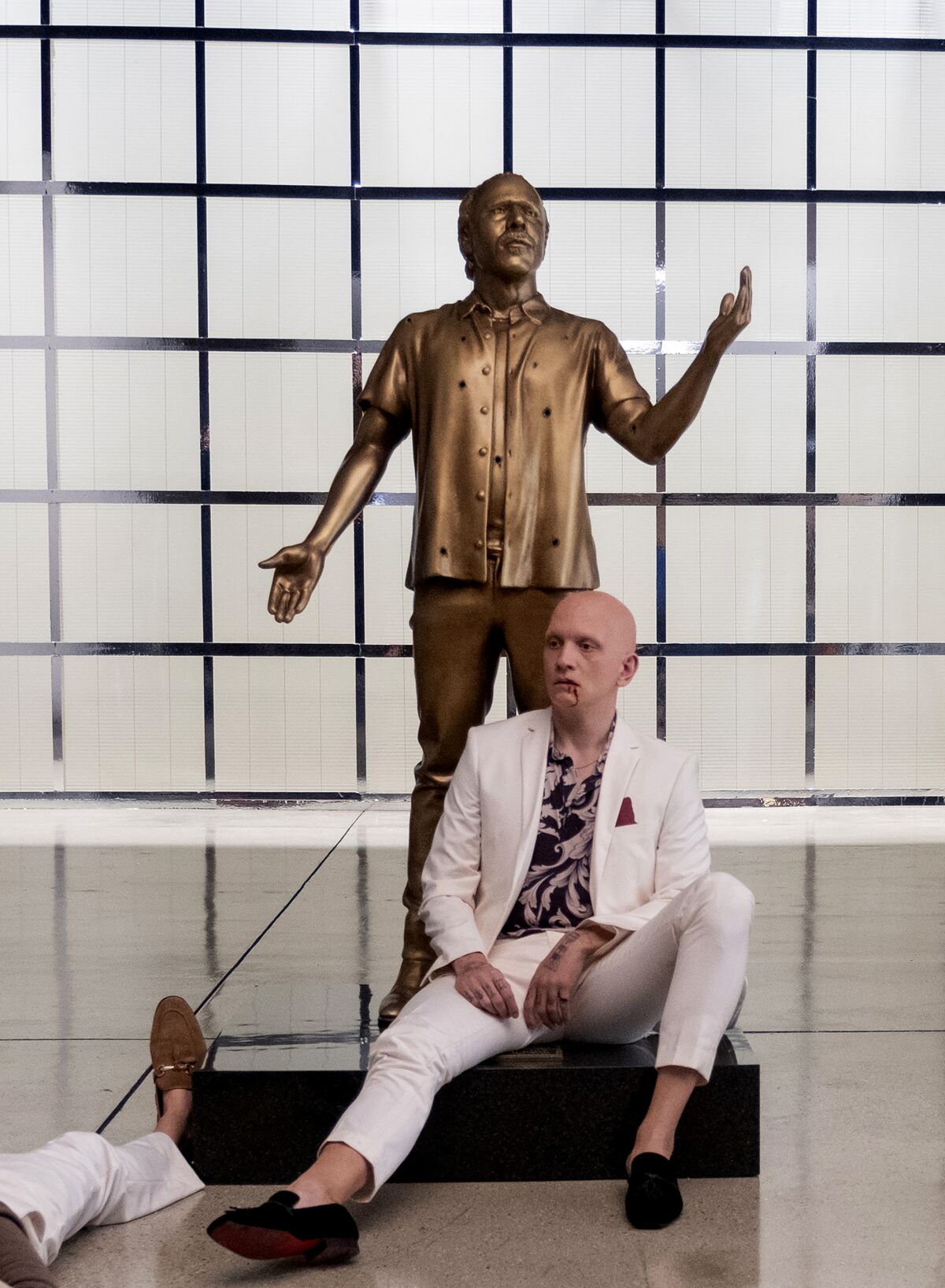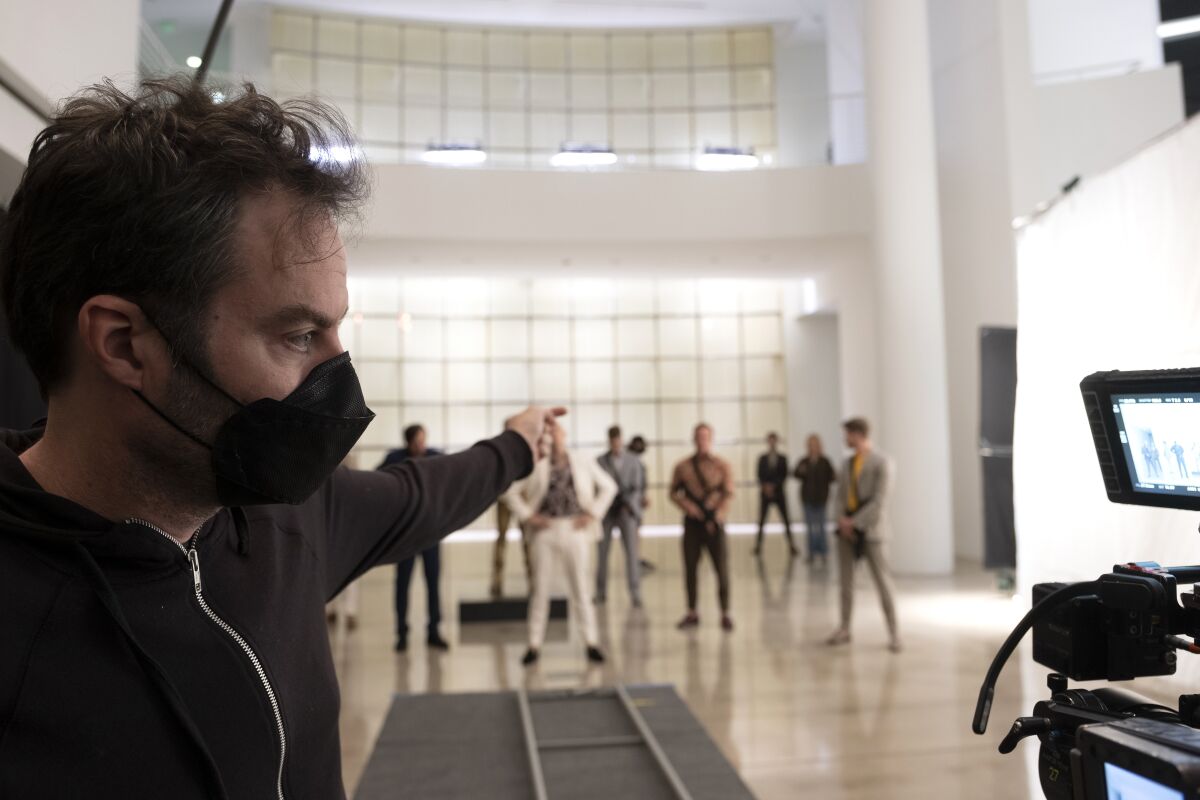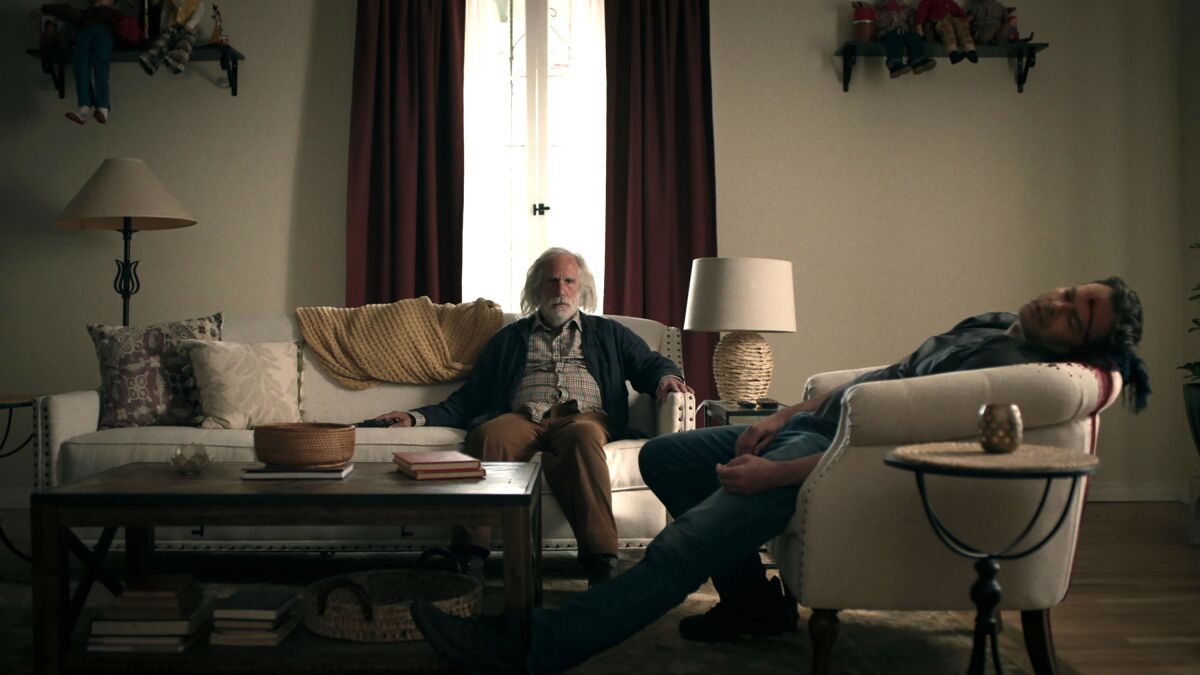
The carnage at the end of the “Barry” finale includes Anthony Carrigan’s NoHo Hank character.
(HBO)
As with its four unpredictable seasons, “Barry’s” last episode, “wow,” did not play out like a typical comedy finale.
That was by design, series co-creator and star Bill Hader told The Envelope on the day he received an Emmy nomination for directing the episode (he’s also up for writing it, lead actor in a comedy series and comedy series). Decisions were often reached by process of elimination or sheer exhaustion; Hader wrote the finale’s script on weekends between directing all of the season’s other episodes. Yet the sudden, emotionally charged reckonings “wow” brought to many of “Barry’s” characters seemed apt conclusions for a show that started with the kooky premise of a hitman who wanted to be an actor, then evolved into one of the most existential crime dramas, not to mention cinematic sitcoms, television’s ever seen.
“Wow’s” centerpiece sequence is one serious piece of filmmaking. Stephen Root’s Monroe Fuches, the man who’s corrupted Barry since childhood and kept him in the murder business between auditions and callbacks, leads his criminal gang to confront rival NoHo Hank’s (Anthony Carrigan) in the lobby of Hank’s absurdly lucrative sand import business. Hader notes that rocket-launching drones and tracer bullet firefights were considered, but what we ultimately see is a much more loaded, nearly still tableau.

Bill Hader directs the series finale of HBO’s “Barry.”
(HBO)
“Initially, it was gonna be more of a standard showdown, written like let’s keep our big, cool action sequence for the last episode,” Hader explains via phone from Seattle. “Then as we were getting closer … I was really tired, and it occurred to me that I just was not interested in a big shootout. It’s already been done, it’s very expected. But you’ve got these two guys together, and then as you write it you go, what if there’s this weird empathy between them? What if Fuches comes in because he’s learned Barry has a kid, he looks at Hank and it’s less ‘I’m going to destroy you’ and more ‘Hey, if you can just admit that you f— up like I admitted I did, we’ll be OK.’ And Hank can’t do it.”
That tight reverse angle exchange between the mortal enemies is among the most intense and revealing of the entire series.
“Bill’s use of the close-up really lends itself to moments of anguish,” says Carrigan — also on nominations morning, earning his third supporting actor nod for the role. “The cameras were millimeters from our faces. Stephen found a way to look at me during that exchange, even if it was just through a tiny window of equipment. I could really feel Stephen’s performance that whole time, and we had to trust what the other person was giving. The camera, with how close it was, was unforgiving and relentless. But it also highlights something that Bill was establishing in the scene itself, which is that there’s nowhere to hide, literally or figuratively, and that creates a remarkable sense of danger.”
Then in less than a minute, almost everybody dies. What appears to be a single locked-off overhead view of dozens of gangsters pulling their guns, firing and falling is actually one of “Barry’s” complicated composite shots. It required multiple passes for pyrotechnics, smoke, stunt players ratcheted up on wires and shattering panes of glass, each time with precise restaging and safety measures. The quick, pain-wracked death tableau has been compared to masterpieces of movie showdowns, but Hader wanted his own effect.
”I wanted this to be the antithesis of cool,” the director says. “When everybody’s already pointed their guns at each other, they’re talking, it’s about building up the suspense. It’s very much like a movie thing — in a great way! — but it’s about movies. I wanted to make something that was almost anti that, that was like, here’s how stupid this is!”
Hank does not survive the shootout, but in his dying gesture touches the hand of the life-size statue he’s erected to the dead lover, Michael Irby’s Cristobal, the once comic relief Chechen lost in his rise to ruthless crime boss. Due to a camera angle issue, Carrigan’s hand couldn’t reach the statue’s hand, so the scene was reshot “With me holding Bill’s hand,” Carrigan recalls. “I’ve got to tell ya, it was so meaningful. It’s just the type of director he is, so committed and does whatever is necessary to get the shot.”
The later scene of Barry’s own demise may play even more anti-climactic, but it involved another complex setup. Believing that his girlfriend Sally (Sarah Goldberg) and their son John (Zachary Golinger) are hiding at their acting teacher Gene Cousineau’s (Emmy winner Henry Winkler, nominated for a fourth time this year) home, an enraged Barry barges in. The perhaps suicidal Cousineau contemplates a pistol elsewhere in the house while Barry finally sees the error of his ways in the living room — then is shot from off-camera.

Henry Winkler’s Gene Cousineau finally takes his revenge on Bill Hader’s killer Barry Berkman.
(HBO)
“I liked that performance,” Hader says. “That was the first take I did of that. It’s the first time you see Barry like he understands. He almost looks and sounds different when he says, ‘You gotta call the cops.’ All the BS goes away and — it’s funny — for like seven seconds, he gets it. Then he gets killed.”
“There are a few things going on in those shots,” explains cinematographer Carl Herse, who was Emmy-nominated for another Season 4 episode, “tricky legacies.” “We’ve been teasing over the course of the series that there’s a parallel between Barry Berkman and Pinocchio, that he wants to be a real human but he lacks the humanity to do that, so when his body goes lifeless that’s echoed by all the dolls on the shelves around him. A more subjective shot is about what Henry’s character is experiencing. Gene has succumbed to Barry’s disease and now he’s killed someone, so it’s all about finding Gene and, as the camera pulls back, you create the sense of a proscenium. That touches on the idea that all of life is a stage, which is kind of what the show is about.”
Funny as he thinks Barry’s death was, Hader admits that he doesn’t really distinguish the show’s comedy from drama. With all its climactic tragedies, “wow” seems light on humor; even its hilarious sight gag of Barry marching down a store’s toy aisle strapped with just-purchased artillery makes a dark comment about gun access in America. But the episode’s last sequence is a virtual fun-house mirror version of everything the show’s about. Years into the future, a teenage John (Jaeden Martell) watches “The Mask Collector,” a Hollywood movie version of his father’s story, painting Barry as a hero. It’s packed with all the melodrama, dumb dialogue, slick camerawork, glamorized violence and heroism we’ve never seen on “Barry.”
“That was definitely a moment where we knew that it was OK to go much more comedy than usual,” says Ali Greer, who with Franky Guttman is Emmy nominated for picture editing “wow.” “What initially was pitched to us was it should mostly focus on John, but as we edited it and showed Bill what we were thinking, it definitely switched. Keeping it short was a struggle because we found everything to be pretty fun, but we had to stay on story and not overindulge in such a silly moment for the final few minutes of the series.”
“My original, 20-minute cut of ‘Mask Collector’ is on a hard drive somewhere,” Guttman adds.
“It really did boil down the essence of the whole show to me,” Hader says with a laugh. “This show that’s supposed to be predicated on, like, in art you’re supposed to be saying what the truth is, but in Hollywood it’s usually a big lie. It was fun to get to dramatize that.”
As was, of course, discovering how to be a great television director.
“It’s something I’ve always wanted to do,” Hader says. “I’m very proud that I got the chance to finally do it and grow and learn. I feel each season was a step in the right direction of figuring out what the job is, and how to create a story with images; that’s really, really exciting. It’s the best job on the planet.”
For all the latest Entertainment News Click Here
For the latest news and updates, follow us on Google News.
